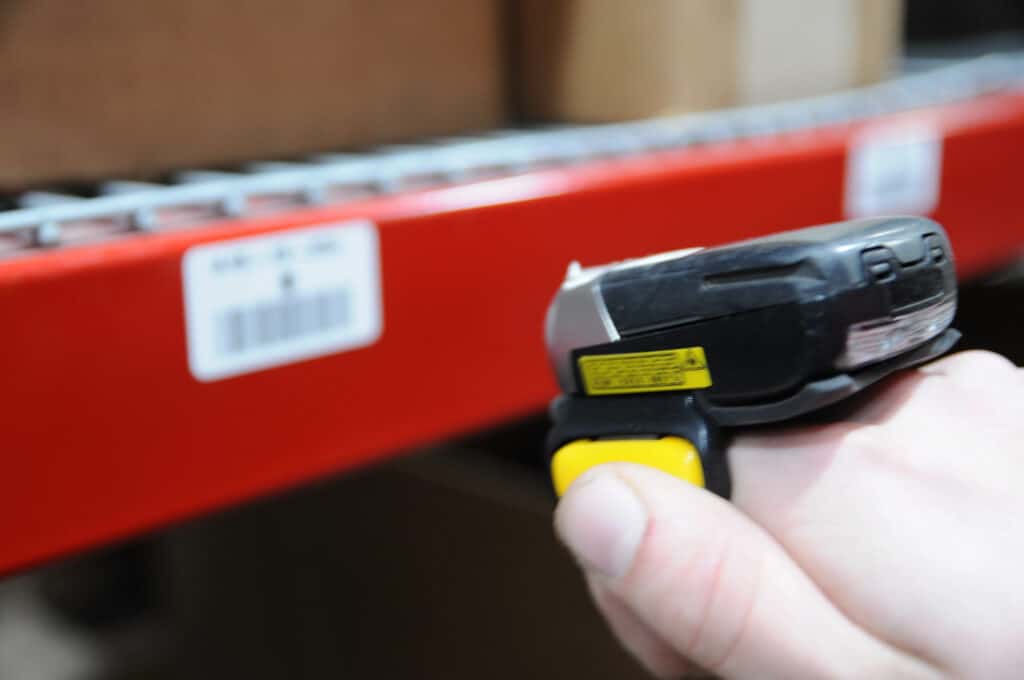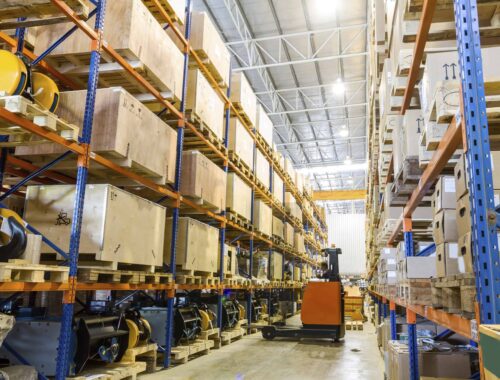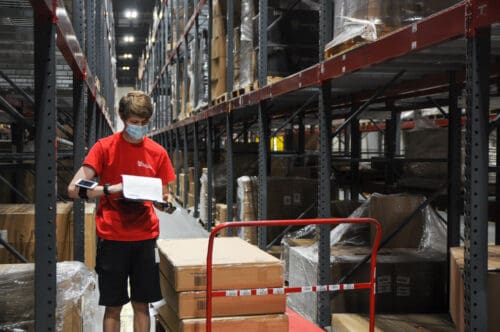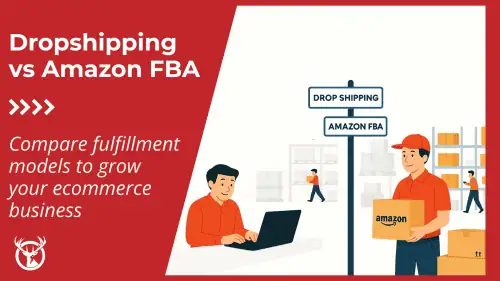One of the first questions new partners and potential customers ask is: What technology can be used to fulfill orders, and what does Red Stag Fulfillment support?
That can be a long answer because, like most things today, there are multiple options to do any job. And technology seems to power more and more of these alternatives. So, this post will look at 10 different types of technology that can be used to fulfill orders and how they might fit into your own company or a partner’s operations. We’ll discuss:
- Software platforms
- Scanners and tags
- Storage solutions
- Smartphone and app usage
- Human-powered carts
- Automated conveyors
- Packing stations
- Trucks and vans
- Robotics
- And what comes next
Order fulfillment covers all the steps a warehouse takes from inventory intake and storage through the final delivery of a complete order to the customer. As we discuss what technology can be used to fulfill orders, we’ll move through the typical steps an order takes from creation to completion.
10 types of tech used to fulfill orders
Information tools
1. eCommerce and order software
We need to start with the platforms that power orders, inventory, and fulfillment practices for our discussion about what technology can be used to fulfill orders. That means the eCommerce platform is where a sale starts and generates necessary order information. Typically, your eCommerce tool will handle initial order creation and hand it off to other order or supply chain software, which is where we’ll focus.
There are many different flavors of supply chain and eCommerce software. Some larger platforms, like ERP tools, may include modules that cover the full suite of capabilities that a WMS offers. On the other hand, smaller packages with core functionality are also available for small and growing operations. So you can use a mix to complete your fulfillment.
The explosion of eCommerce has led to more robust platforms and improvements from companies like Shopify. Today’s eCommerce tools can fully manage and track your orders, integrate with warehouse software, and automatically update customers about fulfillment. Your eCommerce platform captures all relevant order details and provides these in a structured way for the warehouse system. That way, pickers get the right products, packers the correct packaging requirements, and you pick the proper shipping label for the order to be on time.
So, let’s investigate the alphabet soup of supply chain and fulfillment tech.
WMS
Warehouse management systems support the daily activities of a warehouse by design. They support inventory counts, pick and pack, managing equipment, and more. In addition, many WMS integrate with eCommerce and order management systems, so the fulfillment team only needs to use one platform for getting orders out the door.
OMS
Order management systems are back-end tools that companies can use to monitor inventory and fill orders. These are often the integration tool to connect an eCommerce platform and a WMS, passing along the correct information and helping sales or marketing understand which sales channels generate which orders. Now, many eCommerce platforms have built-in OMS tools, so fewer companies need specific OMS software to pass on order data to warehouses, packing stations, and more.
CRM
Customer relationship management software focuses on managing your customer-based interactions. While CRMs initially focused on marketing and sales, they now can track customer accounts and order information. For example, a CRM will often provide order details to a WMS. They can also update orders, change shipping requirements, or finalize a return/exchange when the initial item is checked back into the warehouse inventory.
SCM
Supply chain management tools focus on the nuts-and-bolts activities around fulfillment and supply chains. They’ll track the materials you have on hand, restocking, and the path goods take from manufacturing to the end consumer. SCM tools track a lot of fulfillment data and can help you better understand total costs and turnover times. People don’t generally include SCMs in lists of what technology can be used to fulfill orders. However, an SCM can be useful to optimize processes before and during fulfillment to improve your overall fulfillment capabilities. Also, note that sometimes SCM can be used for the title Supply Chain Manager.
ERP
Enterprise resource planning tools are large systems that monitor a global supply chain. Typically, large companies with multinational sales efforts use ERPs to manage processes like fulfillment and provide detailed analytics of company-wide operations. What sets them apart is their size and their high levels of customization for each company. In addition, ERPs contain many other platforms as modules or add-ons, including WMS, OMS, SCM, and CRM tools.
TMS
Some companies will use transportation management systems in their fulfillment. Generally, these tools support shipments of freight and oversized items, tracking them from a dock to a destination. TMS are useful for procurement and reverse logistics, so manufacturers or 3PL partners are most likely to use them.
Inventory and intake
2. Scanners and tags
Barcodes and tags make warehouse operations significantly easier at every step of fulfillment. They’re essential, from receiving inbound freight and checking inventory levels to picking, packing, and getting something out for delivery. Scanning enables teams to replace manual counts that may miss a box, write down the wrong number, or lose their place due to a distraction.
Barcodes tend to be the default when thinking about labeling technology you’ll use to fulfill orders. Not only does every SKU have its own barcode, but you can also apply custom barcodes to pallets, shelves, and equipment. Scanning as something is used generates a wealth of data. Scanning out a forklift, for example, tracks how often your team uses it. That information helps fulfillment professionals keep up with regular maintenance.
Innovations in barcode scanners focus primarily on how scanners move and operate. Like the ones we use at Red Stag Fulfillment, you wear some on the wrist or finger for fast scanning. A conveyor might have multiple scanners to ensure it scans every product moving down a belt. And now, autonomous scanners are moving through aisles to check barcodes and maintain inventory counts to support fulfillment operations.

RFID is an option too
Beyond barcodes, other standard tech includes radio-frequency identification (RFID) tags and gates. These use electromagnetic fields to access the information stored in the tags. Most tags are passive, meaning they hold information but aren’t actively transmitting it. So, they don’t require a battery.
RFID readers, often called gates, send out radio waves that the passive tags use as power. Gates often track goods as they move through a specific area, such as the receiving location near a dock door. RFID readers have a general range and track any tag that moves within this space, even if the reader doesn’t have a clear line of sight to the object. So, it could tell if there were 10 or 15 tagged items on a pallet moving past even if only a few were directly facing the reader.
Active tags that have batteries or power sources can transmit data to receivers that are tens to hundreds of feet away, making them helpful in maintaining a consistent inventory count in your warehouse.
3. Storage equipment
All that software and tags generate a lot of data. For that information to be helpful, products need an orderly system for storage. That way, it’s easy to ensure you’ve got the right inventory counts and that people or tools know where to go to get each product. Well-defined storage makes a warehouse work. Poor storage increases delays, costs, and customer frustration.
The storage technology most warehouses use will be highly familiar to you. You’ve probably got your own versions within arm’s reach or nearby against a wall. They can also help whether you track inventory individually or by lot. Warehouses customize the exact mix to specific needs. However, some of the most common examples include:
- Product storage racks
- Pallet racks
- Shelves
- Bins and trays
- Storage drums
- Table bins or built-in storage for packing stations
- Custom shelf and bin systems
Shelving is ubiquitous in warehouses. What tends to change is its load or layout. Many products can use standard shelving and bins. However, there are a vast array of custom options for specific products. For example, there are sturdier racks and shelves for heavy products. And, coils or other circular items usually have a frame to sit in, so they don’t roll away.
Picking orders
4. Smartphones and apps
In most warehouses, people are still walking around picking up goods for your order. They then bring those to other people at packing stations that prep, pack, and label every order. Then, they or another team stages goods near loading dock doors to speedily put them into trucks for delivery to customers.
That’s a lot of steps where things can go wrong. So, most companies also employ technology to verify that they’ve assembled orders correctly. Some of the newest and most reliable options for what technology can be used to fulfill orders and verify them turns out to be what you’ve got in your hand, pocket, purse, or on the desk next to you: the smartphone.
Many WMS and inventory tools now offer smartphone apps designed to help warehouses and fulfillment operations. The app delivers the pick list. The phone’s camera scans barcodes as the picker gets everything off the shelf. Packing stations also scan products and match them to a specific order. With this, every order is verified and gets the proper label to get to you on time.
In some advanced cases, smartphones and apps will monitor the user’s progress or even offer real-time directions to help someone find a product location.
5. Carts, hand trucks, and forklifts
Pickers have complex, demanding jobs of collecting products all day. Most will turn to a cart or hand truck to put products down as they get everything for an order. They’re standard technology that can be used to fulfill orders, but many differences exist. It’s important to note that you also can use this loading equipment for inbound freight and outbound packages.
Some options include:
- A single-level or multi-level cart that the picker pulls with them.
- Hand trucks or dollies for stacking heavier goods.
- Motorized carts that use sensors to follow the picker automatically, like a warehouse puppy.
- Pallet jacks for moving pallets or large items that stay at ground level
- Forklifts for large goods and pallets that are especially heavy or stored off the ground
Those are just a few standard solutions. You’ll find many custom elements when you look inside any warehouse. These make it easier for the picker to find and move the right products for orders. For example, companies like DroneScan provide tools to help forklift operators scan products before picking. These tools scan pallets or individual SKU codes and provide feedback on a tablet or display to ensure accuracy, just like other pickers.
6. Conveyors, belts, and rails
Larger warehouses use automated systems to store many of their goods. This can be because of the size and weight of products or the sheer volume of goods they manage. Conveyors, belts, and rail systems efficiently move products around a warehouse and help store them in the proper location. Thankfully, many tools also scan and count goods while doing this, helping companies keep an accurate track of their inventory. You can use that data for any advanced inventory audit.
Conveyor and belt systems are the most used options here. They can route goods around a warehouse and, after being picked, can deliver bins with products to the correct packing station. Sometimes, belt systems also move goods from one end of a warehouse to the other. That’s useful to move large quantities quickly or to allow teams to work in a zone on each end to divide the tasks.
A large warehouse can easily have miles of conveyor belts. That makes them a perfect answer when thinking of what technology can be used to fulfill orders.
Rail systems are a newer version of the same concept. However, instead of being mounted to the ground and having goods travel on top (like conveyors), rails mount to the ceiling or racks and use cradles to hold products or pallets.
Think of them as a ski lift for products.
Rail systems are more common when you’re moving large quantities of goods on pallets or in roll cages. Most are amazingly fast and can move hundreds of pallets per hour. This makes them perfect for industrial applications but less common for eCommerce. Like the one pictured above from Swisslog, newer rail systems can even handle extreme temperatures of -30°C.
Packing and shipping
7. Printers and packing stations
While there are a few fully automated warehouses on the planet, the majority still overwhelmingly rely on people to put products into boxes, tape them up, and get them ready for final order fulfillment. So when considering what technology can be used to fulfill orders at this stage, think about where the people are.
Warehouse staff who are packing boxes get their own packing stations. These are long tables that typically leave on either side of a conveyor or by the shelving closest to dock doors. The tables will have nearly everything someone needs to pack an order. Tasks at packing stations include checking to ensure an order is accurate and complete, packing goods inside a box or multiple boxes, adding filler and packing materials, sealing each box, and affixing the proper label.
Typically, these stations come with scales and measuring tools. Sometimes the packer must take measurements manually, while others can automate both weight and dimension checks of products and packages.
Some systems calculate what box sizes to use based on products in the order. At the order level, systems will use physical and DIM weight to determine shipping pricing and options. Most eCommerce and fulfillment systems can use order information and company preferences to automatically pick the best shipping option based on order speed and cost. Printers at the station then create these labels and the packer affixes it to the box.
From here, the packer moves boxes to a staging area close to dock doors. Teams can do this manually immediately, in bulk via carts at the end of a shift, or using those same conveyor belts.
At the station
The technology used at packing stations can include:
- Barcode, RFID, or label scanners to check products
- Industrial scales for weight
- Scanners and measurement optics
- Computers to access order and warehouse systems
- Printers for shipping labels
- Printers for flyers and inserts
- Shelving and drawers for filler materials
- Overhead lighting to make packing easier
- Slots for boxes
- Machinery to cut custom boxes
- Sealing tools such as tape shooters, heat sealers, gluers, and staple guns
Nearly every station will have reference materials for packing products. These charts or cheat sheets will remind people of special requirements for products or to maintain company branding. They’ll usually be laminated sheets of paper or on the workstation computer. Using computer-based information can speed up the process because it will display only the information relevant to the current order.
Advanced packing stations can also provide fill systems to automatically add filler to boxes after all the products are inside. These may be general dispensers with on/off valves or air tools that push filler into boxes.

8. Trucks, vans, trains, and more
After an order is packed, it’s put on a cart or sent down a conveyor. Next, they send boxes near the loading dock or area. Most warehouses will continue to use the same order and inventory management platforms and tools at this point, such as ERPs and handheld scanners, as they plan to hand these orders off to carriers.
Order tools can automate pickup requests and schedules with carriers to ensure that you’ve got the right trucks coming to pick up your products. Generally, large and mid-sized warehouses will have trailers back up to the loading dock to be filled. Orders are scanned and signed for by the carrier’s staff and then proceed to the carrier’s processing facility.
From there, much of fulfillment is out of your hands. Carriers use a mix of trucks, planes, trains, and vans to move goods along each step. Sometimes it can be a single move where a van leaves the processing facility for direct delivery to the consumer. In other cases, packages will move across the U.S. on a truck or train to the next processing facility. From there, deliveries are sent out in those familiar carrier vans.
If you’re expediting orders, a carrier will often use an aircraft for that middle step. In this case, the next processing facility tends to be located close to the airfield used, minimizing travel distance before packages are sorted and set out for final delivery.
Throughout this entire process, carriers scan packages as they move. Modern ERP and order management tools can get this scan data from carriers automatically, updating you and your customers about where a package is. That powers the tracking information we all use regularly, and warehouse systems can be set to monitor this to benchmark carrier efficiency.
What’s next in tech
9. Robotics and automation
One thing to realize when discussing what technology can be used to fulfill orders is that large parts can be automated, and human tasks replaced with robotics. As a result, the warehouse space has seen a boom of robotics, some that were obvious and others that would’ve been hard to imagine just a few years ago.
Some eCommerce marketplaces that provide their own fulfillment use automated sorting equipment that scans products on a conveyor and automatically routes them to the correct bin via a series of moveable belts, robotic arms, and adjustable bins or shelves. Similar systems can move orders from picking locations down to packing stations and send the correct set of bins or products to the right station to complete an order.
Much of this work depends on computerized routing systems that are part of the WMS and ERP systems discussed above. These automatically adjust all the robotics to deliver goods to the correct locations for putaway or packing. An essential part of the computer-plus-robot combination is the ongoing analysis of warehouse operations. Systems need to be intelligent enough to assign orders to available picking stations without creating a backlog for the people there.
Automation is a significant investment because of the robotics and sensors plus the computing power to gather and use the precise data needed to run a warehouse.

10. Drones in the warehouse
The latest tech to be considered for the warehouse is drones. Many companies first used drones for aerial photography or to take a video of pickers in action. However, drones are now being considered for other use cases. As you may know, drones are a subset of robotics. We wanted to cover them separately because flying changes how they move and navigate around a warehouse.
Today, there are drones available to check barcodes or collect RFID information for regular inventory counts. These systems can be operated by a person or automated and will often fly around a warehouse to scan barcodes and RFID tags after pick-and-pack operations end to update inventory counts. Not only do they create totals, but some gather location data. The WMS or other tools get a full count and can create alerts for any item that’s out of place.
Drones are used sparingly, but these inventory counting capabilities have been in use since at least a 2016 Walmart test. More recently, some manufacturers are trying to create drones that move bins and goods around a warehouse. Amazon has also made public statements about wanting to use drones for last-mile delivery, which will likely play a role in the future of home delivery.

What technology can be used to fulfill orders for me?
Thanks for sticking with us through all of that. When most partners get to this point, they’ve got one specific follow-up question: What technology can be used to fulfill my orders?
Again, the answer will depend on your sales methods, products, and if you run your own fulfillment or partner with someone like Red Stag. You probably won’t use everything listed above. We don’t. Red Stag uses many of these tools — and many of the photos in this post are from our warehouses. However, our focus on heavy and bulky product fulfillment takes some tech off the table. Most robotics struggle with large products, and required upkeep can make them slower and less efficient than having a great team of people.
So, we use technology for strategic advantages. For example, handheld scanners check orders multiple times throughout fulfillment, allowing us to have one of the best accuracy rates in the business. Forklift experts help us store large quantities of goods efficiently. We chose carts to be the most useful for the size of our products and the aisles in our warehouses. It’s purpose-driven.
When considering what technology can be used to fulfill orders, we suggest you take the same purposeful approach. And, like any good partnership, ask questions from the companies where you buy your equipment. In a warehouse, safety, reliability, and accuracy are non-negotiable demands. If you need help or want to learn more, click below to contact us.











